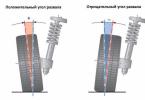Now tinting the taillights with a film is very popular not only among car tuning enthusiasts. Of course, many people try to tint the optics in the first place so that the car looks stylish, stands out in the traffic flow, and attracts the attention of others. But tinting the headlights with a special polymer film has an important utility value: the coating protects the glass of lighting devices from scratches and mechanical damage.
How are front and rear headlights tinted with foil?
Tinting the headlights with film is a relatively simple process, although it requires certain skills and great care.
- It begins with the fact that according to criteria such as color and thickness, the material itself is selected.
- After that, the headlights are prepared. They are thoroughly cleaned from dirt, washed and degreased.
- Next, using sharp scissors or an ordinary clerical knife, a piece of film larger than the headlight is cut off (that is, with a margin).
- It is applied to the surface of the glass, tightly fixed on it, and then gently, to avoid the formation of air bubbles, is smoothed out from the center to the edges.
- In rounded areas, the film is slightly stretched so that it fits better. To soften it, you can use a construction hairdryer.
- After the headlamp is completely covered, the excess film around the edges is carefully trimmed off.
The taillights are tinted using exactly the same technology.
Benefits of headlight tinting
- Protection of the surface of the headlight from damage and chips
- High level of light transmission
- You can remove the film at any time
- Individual appearance of your car
Which is better: to tint the headlights with a film or varnish?
For toning headlights, not only film is used, but also a special varnish. The optics are prepared in the same way (cleaning, rinsing, degreasing), and then they are simply stained. The cost of such tinting turns out to be significantly lower than tinting with a film, but this method has significant drawbacks:
- To carry out work, the headlights must be dismantled;
- It is very difficult to cover glass with varnish evenly;
- Varnish transmits less light than film;
- The varnish under the influence of ultraviolet radiation gradually, but steadily, collapses.
In addition, if the need arises to "tune" the headlights, the film is quickly and easily removed, but it is almost impossible to remove the varnish without damaging the optics. Of course, a VAZ headlight can be simply replaced with a new one without any special financial losses, but the price of a similar device for a foreign car is still quite high.
Examples of our work
Scheme of work
1
We enroll you
at a convenient time.
2
We carry out
work with you.
3
You take away
updated car!
Despite the fact that the procedure for tinting car headlights with film is quite simple, it is better to entrust this work to professionals. Our specialists have vast experience in this matter, all procedures for tinting with a film are performed quickly and with a guarantee. In order to find out how much this service costs, you just need to familiarize yourself with our price list or call us - we will book you at any convenient time, because some of our centers work 24 hours a day!
To add personality to their car, many car owners expose it to a variety of types. Among these types of changes in the appearance of the car, the tint of the taillights is quite popular. Such tuning allows you to slightly change the appearance of the rear of the car. In addition to changing the appearance, the tinting of the rear optical instruments has another positive side - the darkened layer prevents the fading of colored plastic diffuser glasses.
For such tuning, two methods are used - applying varnish to the surface of the glass and a film for tinting the headlights. Each of these methods has its own characteristics of application technology, as well as positive and negative aspects. Therefore, these two methods should be considered in more detail.
Varnish tinting. Advantages, features, method of application
Headlight tinting varnish is chosen by many motorists for several reasons. Firstly, varnishing headlights is a technologically simple operation that can be easily performed in a garage. And secondly, the cost of a varnish can is much lower than that of a film. Because of these two factors, this tinting method is often preferred.
But there are also disadvantages of this method, and they are significant:
- It is no longer possible to remove the applied layer (in case of refusal for some reason from the tinted rear headlights, you will have to change the glass);
- The applied varnish reduces the light transmittance, so you need to take the spraying process very seriously;
- For uniform application of layers, the block headlights must be dismantled from the car;

In general, such headlight tint paint can be used on all optical devices on a car, not just on the taillights. But the issue of tinting lighting devices should be taken seriously, because safety directly depends on the visibility of the light signaling elements.
Car headlight tinting is a common practice to improve the vehicle. First of all, car owners do tuning to give their car a unique appearance. Secondly, the restoration of the headlights is necessary if mechanical damage has occurred. Putting new lights can be financially costly, and tinted with your own hands is much more profitable and easier. If you settled on tinting, for example, taillights, then this material will be relevant for you.
So, there are two main ways to tint the taillights: varnish (or paint) and film. The experts do not answer for sure which method is the best, because all the headlights have a different relief. Now let's talk in more detail about each method. But first, what we need for this job:
- base material (special varnish, paint or tint film);
- device with the thinnest blade (knife);
- masking tape;
- industrial dryer;
- solution for cleaning surfaces or detergents for cars;
- soft, clean cloth;
- napkins;
- degreaser;
- spatula (rubber or silicone).
 Car tinting tools
Car tinting tools Tinted taillights with varnish
All headlights and small parts of the car can be tinted with a special varnish. It is best to choose a translucent black or red varnish. Others are not very convenient to use, but there are cases of tinting to match the color of the car body.
Instructions for tinting the rear lights with varnish:
- Remove the headlights from the vehicle and place them neatly on a work surface in a workshop or garage. If you are not going to remove the headlights, then it is necessary to cover the parts of the body around them with newspapers or other material in order to eliminate the possibility of getting on these areas of varnish.
- Wash the surface to be tinted with detergent and then dry. When the headlight is dry, you need to wipe it with a napkin, treat it with a degreaser.
- It is best to apply the varnish in a dry and well-ventilated area. The can with the substance must be well shaken and sprayed at a distance of 30-40 cm from the part. This will ensure the lanterns are evenly varnished. Each new layer must be applied after the previous one has completely dried. On average, the layer dries for an hour. The more layers, the less transparent the headlight will be. Experts do not recommend making the lights too dark. The optimal number of layers to be applied is two or three. Thus, the headlights will be perfectly tinted, and the normal visibility of the light will remain.
- When the varnish dries, you should install the optics in place in the car. If you just covered the body with materials, then after tinting all extraneous elements must be removed.
 The procedure for tinting the rear lights of the car
The procedure for tinting the rear lights of the car How to tint headlights to match the body color of your car
This can be done with paint or film. The most common color tinting is done with paint. A variety of colors allows you to successfully select the desired body shade. The headlight painting procedure looks the same as varnish tinting, only additional equipment is required: a spray gun and a special compressor. For tinting, you must use a two-component paint, which is then varnished.
You need to prepare the work surface for tinting, as in the previous case. As for the application of the substance, there are several differences. Add paint to the varnish and mix everything well until a homogeneous consistency. Fill the spray gun flask with this liquid, and then apply it to the headlight. Two layers will suffice. The painted part dries from eight to twenty-four hours.
Seven days after tinting, the taillights should be polished with a special paste to make them even brighter and more aesthetically pleasing.
"Pros" and "cons" of tinting
To decide which tinting method you choose, here are the advantages and disadvantages of each option. If we talk about the advantages of tinting with varnish or paint with your own hands, then the following points should be highlighted:
- affordable cost of materials;
- a huge color palette of paints;
- simplicity of the toning algorithm;
- the speed of the procedure.
There are also several negative aspects of tinting with paint or varnish:
- problematic application of the substance in a uniform layer;
- for tinting, the headlights must be removed from the car;
- reducing the transparency of the optics;
- the possibility that in case of inaccuracies and errors, defects will remain on the headlights;
- the coat of paint and varnish deteriorates over time due to the influence of the environment.
Tinting the rear lights with foil
This option is also very common. In this case, you need to pick up a special translucent film. Most car owners prefer black film for car window tinting. If you want to choose a different color, for example, the same shade as the body, in the store you can buy the film of the color you need. Such material is suitable for tinting headlights and taillights, while the quality of the optics will be preserved. The required tinting tools have been listed above.
Particular attention should be paid to the film, as there are materials of different thicknesses and stretches. A thicker film will better protect the optics of the vehicle.
For tinting to be successful, all steps must be performed with concentration, attention and accuracy:
- First of all, you should dismantle the headlights. Otherwise, tinting will not be so successful, and flaws may arise.
- Then - clean the surface of the lanterns from dust and dirt with a detergent and dry.
- Then - directly glue the film with dry or wet technique. The first option is carried out in a warm and dry room. For the second, a soapy solution is needed. The choice of method depends on the type of film, but dry gluing is preferable.
- Before applying the film to the surface, it should be warmed up with an industrial hair dryer. So it will take the necessary shape and fit perfectly on the surface of the headlights. When gluing the film, it must be smoothed with a soft cloth, to remove bumps and blisters.
- At the end of the work, remove excess film.
 Tinting the rear lights with foil
Tinting the rear lights with foil Today, the most common, affordable and effective way to tint the taillights is tinting with film or varnish. Each of these methods has pros and cons, which we will try to understand in this article.
1 Tinting the rear headlights with varnish
Varnish is a simple tinting method that can be used to change the color of any part of automotive optics (headlights, rear lights, turn signals, reflectors, lenses inside the headlight, etc.). The most common colors are classic black and red. It is best to choose varnish from well-known and trusted manufacturers, for example, companies such as Motip, Exoo, Kudo and etc.
Among the disadvantages of varnish are the following:
- The need to remove optics before applying paint
- Reduced light transmission in comparison with film
- The need to replace the headlamp glass in case of refusal of tinting
Despite this, many car enthusiasts prefer this tuning method, since the varnish is more affordable, and its application takes much less time than tinting the taillights with a film.
For varnish you must have:
- Masking tape and scotch tape (matting material with a fleecy base)
- Surface degreaser or soap solution
- Headlight removal tools (screwdrivers, keys, instructions)
- A can of quality paint
First of all, it is necessary to dismantle the taillights, this procedure looks different on each car model. If for some reason you are unable to remove the headlights, it is recommended to use special covering materials (tape, newsprint) so that the varnish does not get on other parts of the body. In this case, work should be done more carefully.
This is followed by the preparation of the surface of the headlight (it does not matter if it is removed or not), for which adhesive tape is used. Spray the surface of the headlight with soapy water evenly, rubbing it with tape-bright until it shines. Next, you need to let the surface dry, and then wipe the headlight with a napkin with a special solvent. So the surface is completely degreased, which means that you can start using varnish.

It is recommended to apply the varnish in a dry and relatively clean room at room temperature and good ventilation. Before opening the can, it is necessary to shake the contents thoroughly, then start spraying paint in even layers at a distance of 30-40 centimeters from the surface, since with a closer approach, smudges can be made. Maximum paint can be applied in 3 layers. If you do more, light transmission will be at a critical level, and this is already contrary to safety rules. After drying and tinting, you can also polish the taillights using a special polishing paste.
2 Tuning taillights with tint film
To tint the taillights with a film with your own hands, you need:
- High quality tint film
- Stationery knife and masking tape
- Spray bottle and soap solution
- Rubber squeegee and industrial hair dryer
Which film to choose for tinting? We recommend purchasing films from well-known manufacturers such as Oracal, SunTek, Sunglass etc. For example, film Oracal 8300 various markings created specifically for tinting optical parts on modern cars.

The most common color options for tinting with film are black, red and yellow.
The application of the film to the headlamp surface is usually done in two ways, "dry" and "wet". The latter is more effective and we will consider it below.
To cover the taillights, attach a standard sheet of tint film to the headlamp, slightly bending it around the edges with a small three centimeter margin. Next, cut the film along the resulting contour using a clerical knife. Degrease the surface of the headlamp in the same way as for tinting with varnish, using adhesive tape, napkins and thinner. After that, dilute the soap solution in a container with a spray bottle, remove the protective layer from the film and moisten the adhesive base with the resulting solution.

Gently apply the film to the surface of the lantern, simultaneously wetting it with water and heating it with a building hair dryer for better elasticity of the material. The film is glued from the center to the edges, while air bubbles must be carefully smoothed out with a squeegee so that the surface is perfectly flat. Cut off the excess pieces of film with a knife, and gently bend the edges as if under the headlight, gluing them with your hands and continuing to moisten with the solution. Next, the new surface of the headlamp should dry. At this, the tinting is ready.
3 Tinting of taillights and legal regulations
As for the legality of toning the taillights, the answer to this question cannot be given unequivocally. The fact is that a police officer may perceive the tinted taillights as a violation of paragraph 3.3 of the current rules, which reads: "External lighting devices do not work in the normal and established mode, or they are dirty and changed." Thus, in some circumstances, the inspector has the right to legally require the motorist to remove the tinting on the spot, it does not matter if a film or varnish was used, and even write out a fine for darkening the optics.

That is why tinting the taillights with varnish is ineffective due to the impossibility of eliminating it on your own if necessary. It will be necessary to completely change the headlight glass, and this is already a certain cost. In some cases, a fine is not provided for tinted rear lights; it is allowed to use a slightly darkened film in a light gray and black shade. Then, let the light transmittance change, but this does not affect the main color, and this is not regulated in any way in the SDA. If a yellow or orange film is pasted on the taillights, then you also most likely will not receive a fine, since the light transmission remains the same as that of standard headlights.

Another way not to get a fine for tinted lights is to contact a specialized service or a tuning studio, where experienced craftsmen know to what extent the optics can be tinted and what materials are best used for this.
Any car owner wants his car to look stylish and be the envy of others. Various methods can help with this: spectacular paints, polishes, vinyl decals and other things. However, when tidying up the body and glass, one should not forget about the taillights. Although they are not the main element in the vehicle, they attract the attention of other drivers and passers-by. Therefore, tinted taillights will not be superfluous if you want to give your car an exclusive look.
Toning methods
It should be remembered that traffic police officers may issue a fine for incorrect toning of headlights. It has nothing to do with the penalty for tinted glass, but the amount of the fine is the same. That is why some people leave the headlights in their original form so as not to get involved with the law. This is not quite the right decision, because it is enough to find out what is allowed and what is not, and then you can safely carry out tuning the car with your own hands. It will not only make the car look more modern, but also protect the headlights from scratches and clouding. Their surface will become even, especially if you cover them with a special film.
There are two main methods of do-it-yourself tinting:
- Painting. This method is considered the most economical, but not easy. You will have to first clean the headlights, grind if necessary and only then paint. This will take a lot of time, and the result does not always come out the way you want to see it. Therefore, it is chosen only by those who do not want to spend a lot of money on tuning.
- Coated with vinyl film. This method is much faster and easier. The only thing that may seem tricky is the wrinkle-free application of the film. Its advantages include the fact that the film can be removed at any time, and the headlights will be in their original form. There are various shades of this material, so you can choose the perfect one for a particular car.

Which of these do-it-yourself tinting methods to choose is up to each driver for himself. They both have advantages and disadvantages, and vary in price and speed of application. Those who save their time are advised to choose tinting with a film.
How to apply paint or varnish with your own hands?
If it was decided to tint the headlights with varnish, then you will need to first purchase a special tool. It is recommended to give preference to tint varnish, which is easy to use. Its price can be high, but the result will be better, and one can is enough.
Toning is carried out in several stages. First of all, you should remove the headlights so that the product lies more evenly. It should be borne in mind that they will need to be installed back, and you need to be able to do this. The next step is to degrease the surface of the headlights; this will require either alcohol or a special tool. After the procedure, you need to let the coating dry.
Before spraying, you need to shake the can, then you can apply the paint in a thin and even layer. After that, you need to allow the headlamp to dry out, while motes should not fall on it. Then you need to apply one or more layers, while not exceeding the norm of light transmission. When the headlights are dry, they need to be polished to a mirror finish and reinstalled on the vehicle.

How to tint headlights with foil?
To do this, you need a hair dryer, a sharp knife, an alcohol solution and a spatula. First you need to clean the headlights by removing moisture from them with a microfiber cloth and a special cleaning agent. After that, you need to spray an alcohol solution on the film and headlights to make them easier to tint.
In order for the film to be even in the shape of the headlights, it must be stretched, which can be done with your own hands using a construction hair dryer. The film needs to be heated to make it flexible, but here it is important not to overdo it, otherwise wrinkles will appear.
The next step is the most important: you need to take a spatula and use it to stretch the material and cover the headlights with a film. Anything that goes beyond the outer edge must be cut off with a knife. It is necessary to do this with your own hands carefully so as not to damage the headlights. This completes the procedure.

Headlight tinting fines
As you know, a ban was introduced on excessive tinting of glass. This was done for safety reasons, as visibility was reduced, and the driver might not notice a pedestrian or any object at night. The headlights do not affect the driver's view in any way, but if they are incorrectly toned, you can not only get a similar fine, but also impede the movement of other vehicles, especially those driving behind.
By law, only white reversing lights and other lighting devices emitting yellow, orange and red are allowed. The film and paint can change the shade, so you need to be careful, otherwise you will have to pay 500 rubles. By the way, an accident can happen from the use of tinted brake lights, and the driver who decided to tint his headlights is recognized as the culprit. Then you will have to pay a fine and an amount for repairing the damaged vehicle.



